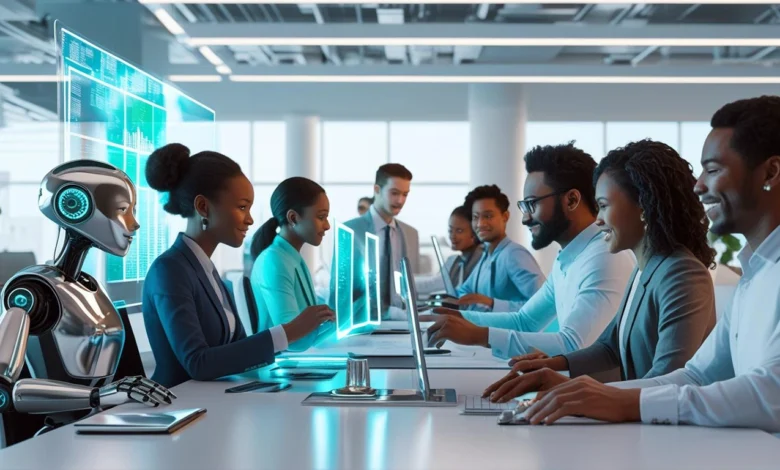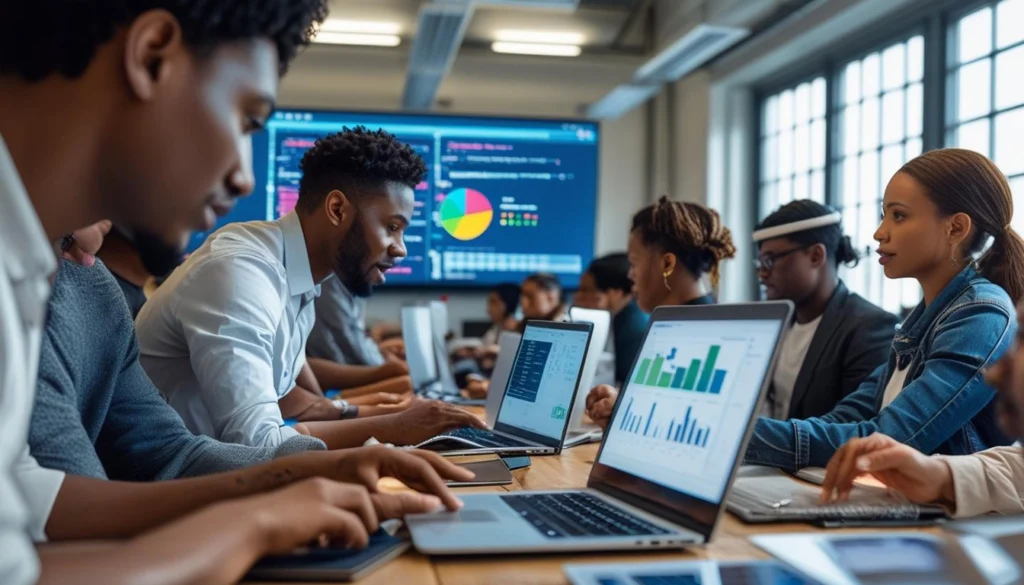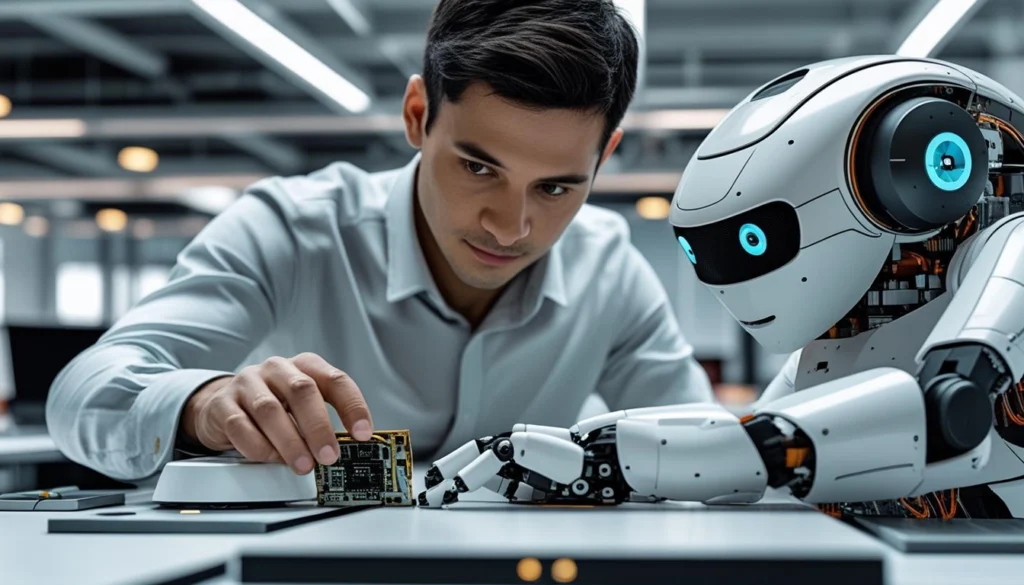Transforming the Future of Work: The Profound Impact of Artificial Intelligence “Your guide 2025 – 2026”

Artificial Intelligence (AI) is more than just a buzzword. It’s changing the way we work in many industries. By 2025, AI will have a big impact on jobs, productivity, and how we work together. This article will look at how AI will change the future of work, both the good and the bad.
The Evolution of AI in the Workplace
AI has been slowly making its way into different sectors over the years. At first, it was mainly used for data analysis and automating simple tasks. But now, thanks to advancements in machine learning and robotics, AI can do much more. It’s used in healthcare, finance, manufacturing, and customer service today.
Case Studies of AI Implementation
- In healthcare, AI is making a big difference. For example, IBM’s Watson helps doctors by analyzing medical data. This improves patient care and makes doctors’ jobs easier.
- In finance, AI helps spot fraud and make smart trades. Companies like JPMorgan Chase use AI to keep an eye on transactions and catch suspicious activity.
- Manufacturing is also seeing changes thanks to AI. Robots are now used to speed up assembly lines. Companies like Tesla use AI to make production faster and cheaper.
- AI chatbots are changing customer service. They provide quick answers to customer questions. This lets human agents focus on more complex issues.
The Dual Nature of AI: Opportunities and Challenges
Job Displacement: A Real Concern
AI is a big worry because it might replace human jobs. A McKinsey report says up to 800 million jobs could be lost by 2030. This makes us think about what jobs will be left.
Industries Most Affected
Some jobs are more at risk from AI. These include:
- Manufacturing: Robots are already taking over assembly line jobs.
- Retail: E-commerce and AI are making some retail jobs obsolete.
- Transportation: Self-driving cars and trucks could replace many jobs in this field.
Job Creation: A Silver Lining
But AI isn’t all bad news. It’s also creating new jobs. The World Economic Forum says AI will bring 133 million new roles by 2022, while eliminating 75 million. This could mean more jobs overall, if people can learn new skills.
Emerging Job Roles
New jobs are coming because of AI. These jobs need different skills. Some examples are:
- AI Ethicist: As AI grows, we need people to think about its ethics.
- Data Scientist: More jobs are opening up for those who can understand AI data.
- AI Trainer: People who can teach AI to learn and make decisions are in demand.

The Skills Gap: Bridging the Divide
The skills gap is a big problem today. Many workers don’t have the skills needed for jobs that use AI. To fix this, we need to focus on retraining and upskilling.
Importance of Reskilling and Upskilling
Companies and governments must invest in training. This training should teach workers the skills they need for AI jobs. This includes:
- Technical Skills: Workers need to learn programming, data analysis, and machine learning.
- Soft Skills: Skills like critical thinking, creativity, and emotional intelligence are becoming more important.

The Positive Impact of AI
AI can make work better by making it more productive and creative. It automates simple tasks, letting workers focus on more complex tasks. This can make jobs more satisfying and engaging.
Enhancing Productivity
AI can make work more efficient by automating tasks. For example, it can handle data entry and customer inquiries. This frees up workers to do more important tasks.
Real-World Examples of Increased Productivity
- Sales and Marketing: AI tools can analyze data to help sales teams. Companies like Salesforce use AI to help close deals.
- Human Resources: AI can help with hiring by automating resume screening. This lets HR focus on interviewing top candidates.
- Project Management: AI can predict delays and resource needs. Tools like Asana and Trello are using AI to help teams manage better.
Fostering Creativity and Innovation
AI can spark creativity and innovation. By doing routine tasks, AI lets workers focus on new ideas. This can lead to new products and services.
Collaborative AI
Collaborative AI is becoming popular. It lets humans and AI work together. For example, AI can quickly analyze data, helping workers make better decisions. This teamwork can improve efficiency and innovation.
Case Studies of AI-Driven Innovation
- Product Development: Companies like Procter & Gamble use AI to understand customer needs. This helps them create better products.
- Creative Industries: AI is used in entertainment to create scripts, music, and art. OpenAI’s GPT-3 has helped create engaging stories for games and films.
- Research and Development: AI is speeding up research in areas like pharmaceuticals. It can analyze compounds to predict their effectiveness, shortening drug development times.
Preparing for the Future
To fully use AI, we need to support workers. This means:
Investing in Education and Training
Companies should offer training in AI skills. Schools need to update their courses to include AI. This prepares students for future jobs.
Promoting Lifelong Learning
Encouraging ongoing learning is key. Companies can offer mentorship, online courses, and workshops. This helps workers stay up-to-date in a changing job market.
Fostering Collaboration
Businesses should use AI in a way that keeps humans at the center. They should involve employees in the AI process and address their job security worries.
Ethical Considerations
As AI grows in the workplace, ethics must be a top priority. Companies should set rules for AI use. This ensures AI helps humans, not replaces them.
The Role of Government and Policy
Governments are key in shaping the future of work with AI. Policymakers need to create plans that help workers and tackle AI challenges.
Supporting Workforce Transition
Governments can help workers move to new roles. They can offer money for training and encourage companies to invest in their employees.

Regulating AI Technologies
As AI grows, rules must be made for its ethical use. This includes looking at data privacy, bias, and job loss.
Promoting Innovation
Governments can boost innovation by funding AI research. This can lead to new industries and jobs.
Conclusion
AI’s impact on work is deep and complex. It brings challenges like job loss and skills gaps. But it also brings chances for better productivity and innovation.
By seeing AI as a tool for teamwork and investing in worker skills, we can succeed. We can make a future where humans and machines work well together.
The key is to adapt and grow with the changing work world. As



